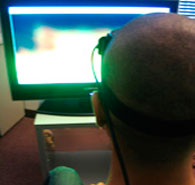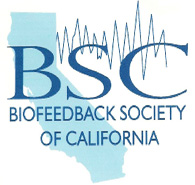Archive for the ‘Biofeedback’ Category
Wednesday, October 3rd, 2007
In working with neurofeedback we find that clinical realities quickly outrun our models. What’s worse, our changing conceptions are not always couched in new terminology that firmly ensconces the new realities and delineates the departure from the past. Sometimes we merely alter our view of words that we have used all along, and must continue to use. And it can also happen that our conceptions are changing beneath our formal awareness.
This is what may have been happening with the central term of our field, self-regulation. I was startled to read the other day a post in which Cory Hammond proposed that “self-regulation be taken out of the definition of neurofeedback.” In its place he would emphasize the processes of learning and conditioning. Traditional self-regulation he saw as connected more with peripheral biofeedback, where one is much more consciously engaged, and where the concept of “voluntary controls” (Menninger) is much more applicable. (more…)
Posted in Biofeedback, Neurofeedback, Paradigm | No Comments »
Thursday, March 1st, 2007
 The new pIR3 is a passive infrared sensor device for biofeedback. Three infrared sensors are mounted in the plastic housing that sits on the forehead and is attached with an adjustable band around the head. Since we are looking at signals from left, right and center, it is important to place the device appropriately so that the label is right side up and the cable extends from the right side of the device. The infrared sensors are not in contact with the forehead, but are held at some distance away so they can measure heat that is radiated from the head. It is important to seat the housing securely (stably) just above the eyebrows. If any hair falls between the forehead and sensors, the signal will be diminished and also more variable, so care must be taken to move any hair out of the way. The new pIR3 is a passive infrared sensor device for biofeedback. Three infrared sensors are mounted in the plastic housing that sits on the forehead and is attached with an adjustable band around the head. Since we are looking at signals from left, right and center, it is important to place the device appropriately so that the label is right side up and the cable extends from the right side of the device. The infrared sensors are not in contact with the forehead, but are held at some distance away so they can measure heat that is radiated from the head. It is important to seat the housing securely (stably) just above the eyebrows. If any hair falls between the forehead and sensors, the signal will be diminished and also more variable, so care must be taken to move any hair out of the way.
The pIR3 follows the lead of Jeff Carmen, who has worked extensively with pIR HEG biofeedback, primarily for migraine headaches. Jeff’s work has used a single sensor for feedback, which is typically placed at Fpz. The pIR3 provides three sensors at approximately Fp1, Fpz and Fp2, and hence the ability to combine the signals as desired for feedback purposes. The pIR3 plugs into any of the three peripheral device inputs on the front of the Neuroamp. BioExplorer software displays the signals and Particle Editor provides additional feedback information and reward. (more…)
Posted in Biofeedback, Hardware Related, PIR / NIR, Research, Software Related | 1 Comment »
Thursday, January 18th, 2007
ABT-Advanced Brain Technologies will be offering a TLP Provider Training Course in Pasadena, CA, on January 26-27, 2007. The Listening Program is a music-based sound therapy program that enhances and extends the effects of Neurofeedback training. We encourage you to consider attending the TLP Provider Training Course and incorporating TLP within your own practice. (more…)
Posted in Biofeedback, Courses | No Comments »
Thursday, January 4th, 2007
 It was my hope that the Biofeedback Society of California Annual Conference would offer a favorable climate for the cross-fertilization between peripheral and EEG biofeedback that now badly needs to occur. In actual fact, the rather large program made for considerable fragmentation and splintering of the audience, as nearly everyone gravitated to their own traditional priorities. Tribalism won out again, an opportunity lost. Sue and I were almost the only ones who actually addressed the main topic of evidence-based practice, but nevertheless our audience was mainly neurofeedback people. It was my hope that the Biofeedback Society of California Annual Conference would offer a favorable climate for the cross-fertilization between peripheral and EEG biofeedback that now badly needs to occur. In actual fact, the rather large program made for considerable fragmentation and splintering of the audience, as nearly everyone gravitated to their own traditional priorities. Tribalism won out again, an opportunity lost. Sue and I were almost the only ones who actually addressed the main topic of evidence-based practice, but nevertheless our audience was mainly neurofeedback people.
The program did, however, offer some real gems that have broad implications for healthcare. Robert Gorter, MD, who is both Associate Professor at the UCSF School of Medicine and head of oncology research at a Berlin hospital, talked of new perspectives in cancer research. Gorter is also involved with anthroposophical medicine in Europe, which attempts to practice more naturalistically and comprehensively. The thrust in cancer research is toward strategies of immunomodulation, with cancer largely seen as an immune deficiency condition. Our immune systems are conducting a perpetual campaign against tumor formation. That is the steady state. When that process fails, boosting the immune system should be invoked as a remedy. (more…)
Posted in Biofeedback, Conferences, Neurofeedback, Research | No Comments »
Wednesday, March 29th, 2006
The lead article in the current issue of the electrical engineer’s magazine, IEEE Spectrum, appears under the heading of “Psychiatry goes Electric” and is titled, “Psychiatry’s Shocking New Tools.” The article is remarkable not so much for what it covers as for the fact that it exists at all in this forum. The article covers vagal nerve stimulators, repetitive transcranial magnetic stimulation (rTMS), dc current stimulation, and finally deep brain stimulation.
The article illustrates the process by which bio-electrical therapeutic techniques will come to be accepted. Each of these procedures will contribute its piece to the growing realization that the brain must be understood in its bioelectrical functioning, and that such understanding will have important therapeutic implications. The article does dwell at length on the level of scientific evidence that supports each technique, but the cumulative weight of evidence–though individually fragmentary–may well carry the day before any one of the techniques independently reaches technical maturity. (more…)
Posted in Biofeedback, Diffusion of Innovation, Paradigm | No Comments »
|
|
Subscribe to Email Newsletter
The EEG Info Newsletter circulates via email at least once a month. A variety of topics related to the Neurofeedback / EEG Biofeedback field are covered in over 200 articles.
|

 The new pIR3 is a passive infrared sensor device for biofeedback. Three infrared sensors are mounted in the plastic housing that sits on the forehead and is attached with an adjustable band around the head. Since we are looking at signals from left, right and center, it is important to place the device appropriately so that the label is right side up and the cable extends from the right side of the device. The infrared sensors are not in contact with the forehead, but are held at some distance away so they can measure heat that is radiated from the head. It is important to seat the housing securely (stably) just above the eyebrows. If any hair falls between the forehead and sensors, the signal will be diminished and also more variable, so care must be taken to move any hair out of the way.
The new pIR3 is a passive infrared sensor device for biofeedback. Three infrared sensors are mounted in the plastic housing that sits on the forehead and is attached with an adjustable band around the head. Since we are looking at signals from left, right and center, it is important to place the device appropriately so that the label is right side up and the cable extends from the right side of the device. The infrared sensors are not in contact with the forehead, but are held at some distance away so they can measure heat that is radiated from the head. It is important to seat the housing securely (stably) just above the eyebrows. If any hair falls between the forehead and sensors, the signal will be diminished and also more variable, so care must be taken to move any hair out of the way. It was my hope that the Biofeedback Society of California Annual Conference would offer a favorable climate for the cross-fertilization between peripheral and EEG biofeedback that now badly needs to occur. In actual fact, the rather large program made for considerable fragmentation and splintering of the audience, as nearly everyone gravitated to their own traditional priorities. Tribalism won out again, an opportunity lost. Sue and I were almost the only ones who actually addressed the main topic of evidence-based practice, but nevertheless our audience was mainly neurofeedback people.
It was my hope that the Biofeedback Society of California Annual Conference would offer a favorable climate for the cross-fertilization between peripheral and EEG biofeedback that now badly needs to occur. In actual fact, the rather large program made for considerable fragmentation and splintering of the audience, as nearly everyone gravitated to their own traditional priorities. Tribalism won out again, an opportunity lost. Sue and I were almost the only ones who actually addressed the main topic of evidence-based practice, but nevertheless our audience was mainly neurofeedback people.